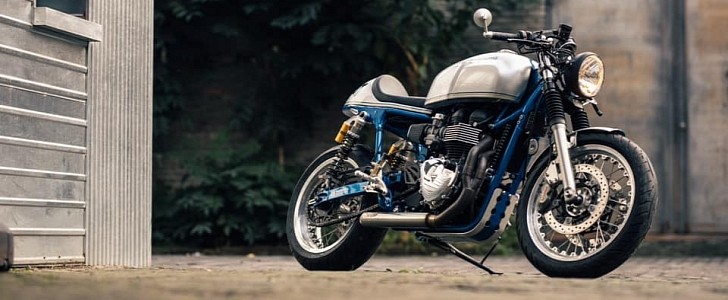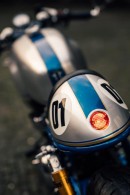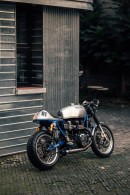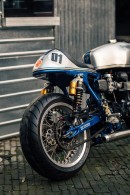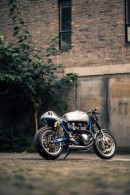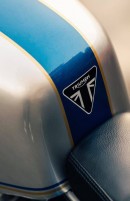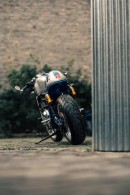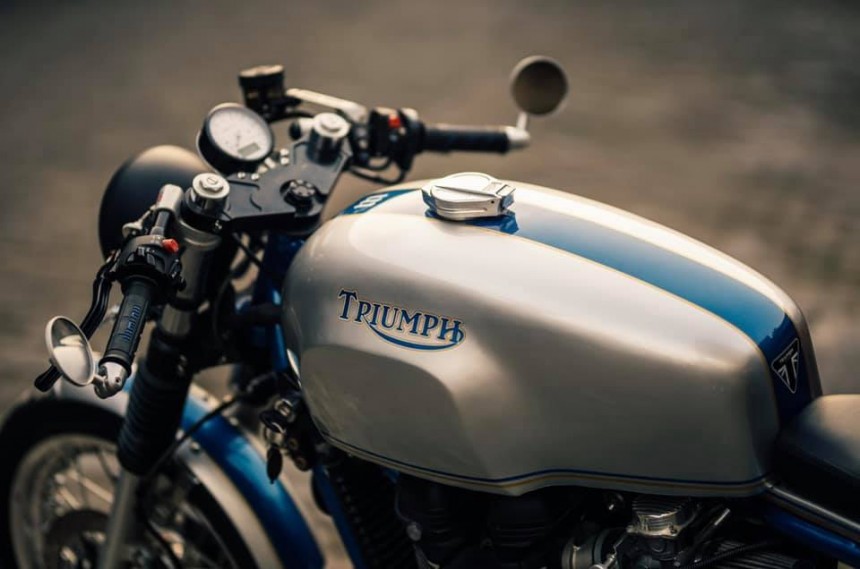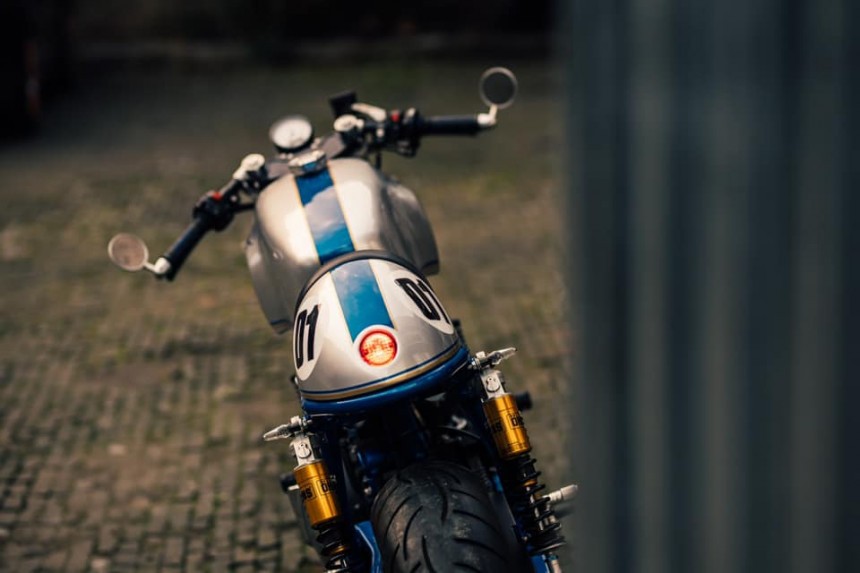The vast majority of its stock components were either revised or discarded altogether, making room for bespoke apparel and a myriad of higher-spec goodies.
Almost 120 years have elapsed since Johann Schulte designed the very first Triumph motorcycle, which employed a 2.25-bhp Minerva engine and a bicycle frame. When the Great War broke out in 1914, the Brits were already assembling around 4,000 civilian bikes per year, with a further 30,000 copies of the military-spec Type H Roadster being delivered to the Entente Forces during WWI.
After the conflict had ceased in 1918, Triumph’s annual production figures continued to surge, reaching approximately 25k units by the late ‘20s. As of 1937, the Coventry-based manufacturer unleashed the iconic Speed Twin – a 500cc, 27-bhp predator that’s been developed by Edward Turner, weighing in at just 361 pounds (164 kg). Needless to say, these machines were extremely advanced for their time, and thousands of copies have been ordered by London’s law enforcement institutions.
With the Second World War on Britain’s doorstep, Triumph opened a new facility in Meriden to meet the increasing demand for battlefield-bred motorcycles. In total, a whopping 50,000 specimens were produced for military use between 1939 and ‘45. As we fast-forward to 1955, we find Johnny Allen setting a land speed record of 193 mph (310 kph) at the Bonneville Salt Flats in Utah, where he piloted the legendary “Devil’s Arrow” streamliner powered by a modified 650cc Triumph mill.
Three years later, Edward Turner’s revered Triumph Bonneville T120 debuted at the Earls Court Motorcycle Show, with the first production variants arriving in dealerships for the 1959 model-year. In spite of the company’s painful decline during the mid-seventies, the Bonneville nameplate simply refused to be discontinued for good, so a fresh incarnation emerged from the firm’s Hinckley headquarters back in 2001.
Today, the Bonnie is still alive and well, featuring several upgrades and liquid-cooled engines with 64 or 79 ponies on tap, depending on the trim. However, the custom marvel we’ll be examining below started with an air-cooled Bonneville T100 from Triumph’s lineup, which has been overhauled by the Chinese moto shamans over at Luo Hao’s Beijing-based Mandrill Garage.
To kick things off, the Mandrill specialists removed the bike’s standard bodywork in its entirety, along with the handlebars, airbox, and exhaust. With these items discarded, the crew proceeded to unlock some additional oomph by installing a set of free-flowing K&N air filters and a neat two-into-one exhaust system from Zard. To make sure the new components will work harmoniously, a thorough ECU remap has also been performed.
Next, the stock wheels were deleted to make way for lighter aluminum alternatives from Kineo’s inventory, wearing high-grade Roadtec Z8 rubber developed by Metzeler. As far as the creature’s bespoke outfit is concerned, the Bonneville flaunts a slim front fender, seamless upholstery, and a unique alloy gas chamber with SportClassic vibes, as well as a handmade cafe racer-style tail section that sits on tthe revised framework.
A healthy dose of extra stopping power is made possible thanks to premium front brake rotors and four-piston Brembo calipers. Up front, the original telescopic forks – which are held in place by CNC-machined triple clamps – have been rebuilt using an assortment of top-shelf internals, while the rear suspension setup was honored with state-of-the-art piggyback shocks from Ohlins. Bonnie’s cockpit comes equipped with Motogadget’s groovy Chronoclassic gauge and a fresh pair of LSL clip-ons, featuring bar-end mirrors, Brembo levers and Domino grips.
The Motogadget experts are also responsible for supplying the m-Blaze blinkers that flank the headlight. As we glance rearward, we’re greeted by bolt-on foot pegs, LED turn signals, and an aftermarket chain guard. For the finishing touches, the head-turner's swingarm and tubular steel frame were coated in a tasty layer of blue paint. The bodywork was enveloped in a silver base, which is accompanied by a blue stripe that runs from the front fender to the tail.
After the conflict had ceased in 1918, Triumph’s annual production figures continued to surge, reaching approximately 25k units by the late ‘20s. As of 1937, the Coventry-based manufacturer unleashed the iconic Speed Twin – a 500cc, 27-bhp predator that’s been developed by Edward Turner, weighing in at just 361 pounds (164 kg). Needless to say, these machines were extremely advanced for their time, and thousands of copies have been ordered by London’s law enforcement institutions.
With the Second World War on Britain’s doorstep, Triumph opened a new facility in Meriden to meet the increasing demand for battlefield-bred motorcycles. In total, a whopping 50,000 specimens were produced for military use between 1939 and ‘45. As we fast-forward to 1955, we find Johnny Allen setting a land speed record of 193 mph (310 kph) at the Bonneville Salt Flats in Utah, where he piloted the legendary “Devil’s Arrow” streamliner powered by a modified 650cc Triumph mill.
Today, the Bonnie is still alive and well, featuring several upgrades and liquid-cooled engines with 64 or 79 ponies on tap, depending on the trim. However, the custom marvel we’ll be examining below started with an air-cooled Bonneville T100 from Triumph’s lineup, which has been overhauled by the Chinese moto shamans over at Luo Hao’s Beijing-based Mandrill Garage.
To kick things off, the Mandrill specialists removed the bike’s standard bodywork in its entirety, along with the handlebars, airbox, and exhaust. With these items discarded, the crew proceeded to unlock some additional oomph by installing a set of free-flowing K&N air filters and a neat two-into-one exhaust system from Zard. To make sure the new components will work harmoniously, a thorough ECU remap has also been performed.
A healthy dose of extra stopping power is made possible thanks to premium front brake rotors and four-piston Brembo calipers. Up front, the original telescopic forks – which are held in place by CNC-machined triple clamps – have been rebuilt using an assortment of top-shelf internals, while the rear suspension setup was honored with state-of-the-art piggyback shocks from Ohlins. Bonnie’s cockpit comes equipped with Motogadget’s groovy Chronoclassic gauge and a fresh pair of LSL clip-ons, featuring bar-end mirrors, Brembo levers and Domino grips.
The Motogadget experts are also responsible for supplying the m-Blaze blinkers that flank the headlight. As we glance rearward, we’re greeted by bolt-on foot pegs, LED turn signals, and an aftermarket chain guard. For the finishing touches, the head-turner's swingarm and tubular steel frame were coated in a tasty layer of blue paint. The bodywork was enveloped in a silver base, which is accompanied by a blue stripe that runs from the front fender to the tail.
